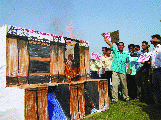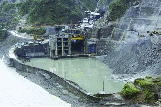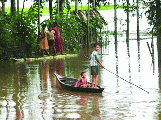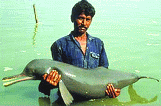Anti Mega Dam Protests Vs ‘Hydro Dollar’ Dream
Anti Mega Dam Protests Vs ‘Hydro Dollar’ Dream
Even as Arunachal Pradesh is dreaming of floating in ‘Hydro Dollars’ by harnessing its huge hydro power  potential to the tune of 57,000 Mega Watts, the intensified anti-mega dam protests, more particularly against the construction of the 2000 Mega Watt Subansiri Lower Hydro Electric Project at Gerukamukh, that falls partially in Assam and partially in Arunachal Pradesh, have become a stumbling block for the state in achieving its desired goal of becoming the powerhouse of the country.
potential to the tune of 57,000 Mega Watts, the intensified anti-mega dam protests, more particularly against the construction of the 2000 Mega Watt Subansiri Lower Hydro Electric Project at Gerukamukh, that falls partially in Assam and partially in Arunachal Pradesh, have become a stumbling block for the state in achieving its desired goal of becoming the powerhouse of the country.
Over the past several years various organizations including the All Assam Students Union (AASU), Takam Mising Porin Kebang (TMPK), Krishak Mukti Sangram Samiti (KMSS) besides others in Assam have been demanding a halt to the construction of the ambitious Lower Subansiri Hydro Electric Project of the National Hydroelectric Power Corporation (NHPC) apprehending adverse downstream impact. As these protest movements are growing in Assam, an Expert Group formed to assess the downstream impact of the project in its final report submitted in June has recommended a halt to the construction of the mega dam at the present site. The Expert Group comprising of experts from IIT, Guwahati, Gauhati University and Dibrugarh University also recommended redesigning of the project by sufficiently reducing the dam height and production capacity. The Expert Group, which was formed jointly by the Ministry of Power, Government of Assam, All Assam Students Union and NHPC on September 2008, also suggested against considering the Himalayan foothills for any mega hydropower project with regard to the geological, tectonic and seismological points of view.
As these protest movements are growing in Assam, an Expert Group formed to assess the downstream impact of the project in its final report submitted in June has recommended a halt to the construction of the mega dam at the present site. The Expert Group comprising of experts from IIT, Guwahati, Gauhati University and Dibrugarh University also recommended redesigning of the project by sufficiently reducing the dam height and production capacity. The Expert Group, which was formed jointly by the Ministry of Power, Government of Assam, All Assam Students Union and NHPC on September 2008, also suggested against considering the Himalayan foothills for any mega hydropower project with regard to the geological, tectonic and seismological points of view.
A House Committee of the Assam Assembly has also in its final report backed the Expert Group’s final report  and recommended to the Assam government to take up this report with the Government of India without delay. The House Committee, which was constituted to study/examine the impacts on the downstream areas of the rivers in the state of Assam due to construction of big dams (for Hydel Power Generation) in the upper reaches of the Brahmaputra water system located in the neighbouring state of Arunachal Pradesh too, recommended that no dams should be allowed to be constructed in the neighbouring states without proper and comprehensive scientific downstream impact assessment. The report was submitted on July 17 on the floor of the Assam Legislative Assembly. The House Committee report also recommended that multipurpose provisions like irrigation, flood control, anti-erosion measures and embankments etc. should be included for the downstream areas in all future hydroelectric power projects in the Northeastern Region and that these should be planned with proper and comprehensive downstream impact assessment.
and recommended to the Assam government to take up this report with the Government of India without delay. The House Committee, which was constituted to study/examine the impacts on the downstream areas of the rivers in the state of Assam due to construction of big dams (for Hydel Power Generation) in the upper reaches of the Brahmaputra water system located in the neighbouring state of Arunachal Pradesh too, recommended that no dams should be allowed to be constructed in the neighbouring states without proper and comprehensive scientific downstream impact assessment. The report was submitted on July 17 on the floor of the Assam Legislative Assembly. The House Committee report also recommended that multipurpose provisions like irrigation, flood control, anti-erosion measures and embankments etc. should be included for the downstream areas in all future hydroelectric power projects in the Northeastern Region and that these should be planned with proper and comprehensive downstream impact assessment.
These two sets of reports, one by the Expert Group and the other by the House Committee, have only become fodder for the anti-mega dam protests.
The issue has also reached Delhi’s Durbar with Assam Chief Minister Tarun Gogoi echoing the concern of his government over the Lower Subansiri as well as other hydropower projects coming up in the upper reaches of the River Brahmaputra, at the 55th meeting of the National Development Council (NDC), the highest policy making body of the country on developmental issues, convened to discussed the mid-term appraisal of the 11th Five Year Plan, held on July 24. Mr. Gogoi insisted that flood moderation should be a critical component of the Lower Subansiri Hydro Electric Project. He also backed the Mid Term Appraisal report of the Planning Commission that mentions that construction of large and moderate storage reservoirs is effective and a reasonably permanent solution to the vexed flood and erosion problems. The Assam Chief Minister relied on the Section 17.2 of the National Water Policy of 2002 which categorically states, “Adequate flood cushion be provided in water storage projects where feasible, to facilitate better flood management in highly flood prone area, flood control should be given overriding consideration in reservoir policy even at the cost of sacrificing some irrigation and power benefits,” to push his case at the NDC meeting. He insisted that various multipurpose projects proposed in the Master Plan prepared by the Brahmaputra Board viz, Tipaimukh, Pagladiya, Kameng, Siang etc. should be taken up as storage projects so that riparian rights of Assam are not denied and flood moderation is taken due care of. Mr. Gogoi urged the Government of India to take up the matter of constitution of North East Water Resource Authority (NEWRA) with the Government of Arunachal Pradesh in the interest of the downstream areas in the Brahmaputra valley. The NEWRA could not be formed till date because of the reservations of Arunachal Pradesh.
Assam’s opposition to the construction of the Lower Subansiri project stems from the twin problems of flood and erosion which have now assumed menacing form and apprehensions that mega-dams in upstream areas without taking into consideration the twin problems will only aggravate them further. The Brahmaputra, Barak and their tributaries have eroded 4.27 lakh hectares of fertile land, 2534 villages and affected 90700 families since 1954. The total estimated damage caused by floods since 1954 is to the tune of 6500 crores.
Immediately after the submission of the report of the Expert Group, the All Assam Student’s Association spearheaded a statewide campaign for immediate implementation of the recommendations by the Expert Group and halt to construction work of the Lower Subansiri Hydroelectric Project. The Krishak Mukti Sangram Samiti, on the other hand organized a massive rally in Guwahati on the 14th of July which was addressed by Narmda Bachao Andolan (NBA) leader Medha Patekar. These two organisations have also accused the Tarun Gogoi-led Congress coalition government of becoming subservient to the pro-mega dam lobby. The issue has reached the centre stage in Assam’s politics with the opposition parties also voicing the demand for an immediate halt to the project and accusing the ruling party of supporting mega dams.
The Lower Subansiri Project dates back to 1955 which was originally a 122 meter high dam multi-purpose project aimed at flood control and irrigation, near the present dam site initiated by the Brahmaputra Flood Control Commission. The Commission later redesigned it to be constructed at the present site and a 257 high rockfill dam was proposed in 1977. The height was subsequently reduced to 116 meters on the ground that some towns of Arunachal Pradesh would be flooded if the proposed height was maintained. The project was handed over to NHPC by the Brahmaputra Board in May 2000. The Lower Subonsiri Basin in Assam supports an immensely diverse ethnic population, groups that rely on traditional agriculture, fishery and allied activities as their main livelihood. However, the ongoing Lower Subansiri Hydro Electric Project in the foothills will have a cumulative impact of different dimensions and magnitudes right from the immediate downstream to confluence with the Brahmaputra. The downstream people are primarily cultivators. Owing to poor road conditions, these people use various rivers including the Subansiri as a means of communication and also as transportation routes. The Expert Group apprehends that the mega dam will result in low flow of water during dry seasons restricting the movement through the river routes for country boats, while during summer, sudden release of excess water from the reservoir when rivers are in spate will disrupt the communication and transportation networks.
The Lower Subonsiri Basin in Assam supports an immensely diverse ethnic population, groups that rely on traditional agriculture, fishery and allied activities as their main livelihood. However, the ongoing Lower Subansiri Hydro Electric Project in the foothills will have a cumulative impact of different dimensions and magnitudes right from the immediate downstream to confluence with the Brahmaputra. The downstream people are primarily cultivators. Owing to poor road conditions, these people use various rivers including the Subansiri as a means of communication and also as transportation routes. The Expert Group apprehends that the mega dam will result in low flow of water during dry seasons restricting the movement through the river routes for country boats, while during summer, sudden release of excess water from the reservoir when rivers are in spate will disrupt the communication and transportation networks.
The study has further shown that the downstream river harbours wide-ranging fish varieties with a considerable 138 species of fish and other aquatic animals including freshwater river dolphins. Any alteration of the river flow and physic-chemical characteristic of the water will have an adverse impact on the whole eco-system. The riparian ecosystem along the river includes 230 plant species, 308 bird varieties, 19 mammals and other animals, the study states.
While strongly recommending the redesigning of the present dam, the Expert Group has also suggested a series of recommendations and observations of the redesigned dam. Some of these include:
1. The inevitable siltration problem and its management are not properly addressed by NHPC. To regulate the resulting siltration problem frequent flushing of the sediments to the downstream and dredging of river bed to maintain the original bed level is to be carried out throughout the river course.
2. The spillway design is based on the recorded maximum discharge of 12,024 cumec, whereas the maximum discharge recorded was more than 21,230 cumec on July 11, 1971.
Some of the major observations of the Expert Group include, “Proper site selection, such as avoiding building dams on the mainstream of a river system and better dam design can play significant roles in minimizing adverse impact on fish, wildlife, as well as people living in the downstream areas. Provisions of fish passes, use of hydrological data to improve the replication of natural stream flow, and also emphasis on appropriate temperature and oxygenation of water released downstream can significantly improve the operation of large dams. There is an urgent need to apply an integrated river basin management approach to balance the sociologists, economists and environmentalists. Such a type of programme will definitely help in sustainability of river dolphins in the Subansiri.”
It further observes that “A large dam like the Lower Subansiri dam should aim to minimize adverse environmental impact, and there should be a strong legal framework to facilitate the ecological security of endangered and vulnerable species like river dolphins. The project appears to influence and modify the terrestrial ecology largely.”
In the event of the reports of the Expert Group, the Assam Assembly Committee, intensified protests and the Assam Government raising the issue at the NDC meeting, the Government of India will now be under tremendous pressure to take up the issue with the Arunachal Pradesh Government as well as power developers like NHPC. As harnessing of this huge power potential is critical to the overall development of the country in general and Arunachal Pradesh and the North East in particular, all stakeholders will need to have a rational view of the whole issue rather than being swayed by emotions. The anti mega dam protestors have tactfully avoided an important recommendation of the Expert Group for redesigning the Lower Subansiri Project and are more focused on stopping the construction work. Such an ambiguous stand may prove counterproductive to the overall development of the North East region which is still lagging far behind the country’s mainstream.
Ratna Bharali Talukdar
